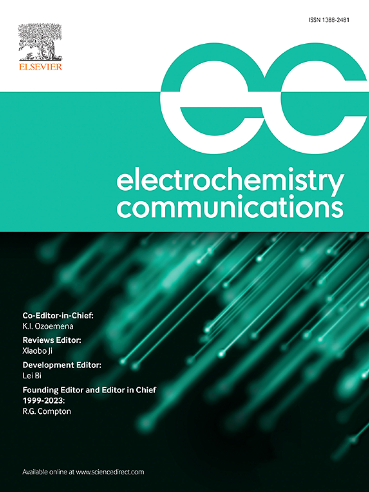Electrochemical detection of uric acid based on platinum nanoparticles/graphdiyne hybrids
IF 4.2
3区 工程技术
Q2 ELECTROCHEMISTRY
引用次数: 0
Abstract
The development of cost-effective and high-performance electrochemical sensors for uric acid (UA) detection is critical due to its role as a key biomarker in disease diagnosis. This study presents an innovative sensor based on platinum nanoparticle (Pt NPs) decorated graphdiyne (GDY) nanohybrid (denoted as Pt NPs/GDY), fabricated via a facile electroless deposition method. The hybrid material capitalizes on the synergistic effects of GDY's π-electron-rich structure - enhancing target affinity through π-π stacking, and Pt NPs' dual functionality as conductivity boosters and catalytic activators. Electrochemical evaluations revealed that the Pt NPs/GDY-modified glassy carbon electrode (GCE) outperforms conventional GDY/GCE and bare GCE, achieving a broad linear range (0.1–7.5 μM) and an ultralow detection limit (30 nM). The sensor also demonstrated exceptional reproducibility, long-term stability, and selectivity against common interferents, validated by successful UA quantification in human urine samples (92.8–98.5 % recovery).
基于铂纳米粒子/石墨炔复合物的尿酸电化学检测
由于尿酸是疾病诊断中的关键生物标志物,因此开发具有成本效益和高性能的电化学传感器用于尿酸检测至关重要。本研究提出了一种基于铂纳米粒子(Pt NPs)修饰石墨炔(GDY)纳米杂化物(记为Pt NPs/GDY)的新型传感器,该传感器通过简单的化学沉积方法制备。该杂化材料利用了GDY π-富电子结构的协同效应——通过π-π堆叠增强靶亲和力,以及Pt NPs作为电导率助推器和催化活化剂的双重功能。电化学评价表明,Pt NPs/GDY修饰的玻碳电极(GCE)具有较宽的线性范围(0.1 ~ 7.5 μM)和超低的检测限(30 nM),优于传统的GDY/GCE和裸GCE。该传感器还表现出卓越的重复性、长期稳定性和对常见干扰的选择性,通过成功地对人尿样品进行UA定量(回收率为92.8 - 98.5%)进行验证。
本文章由计算机程序翻译,如有差异,请以英文原文为准。
求助全文
约1分钟内获得全文
求助全文
来源期刊

Electrochemistry Communications
工程技术-电化学
CiteScore
8.50
自引率
3.70%
发文量
160
审稿时长
1.2 months
期刊介绍:
Electrochemistry Communications is an open access journal providing fast dissemination of short communications, full communications and mini reviews covering the whole field of electrochemistry which merit urgent publication. Short communications are limited to a maximum of 20,000 characters (including spaces) while full communications and mini reviews are limited to 25,000 characters (including spaces). Supplementary information is permitted for full communications and mini reviews but not for short communications. We aim to be the fastest journal in electrochemistry for these types of papers.
 求助内容:
求助内容: 应助结果提醒方式:
应助结果提醒方式:


